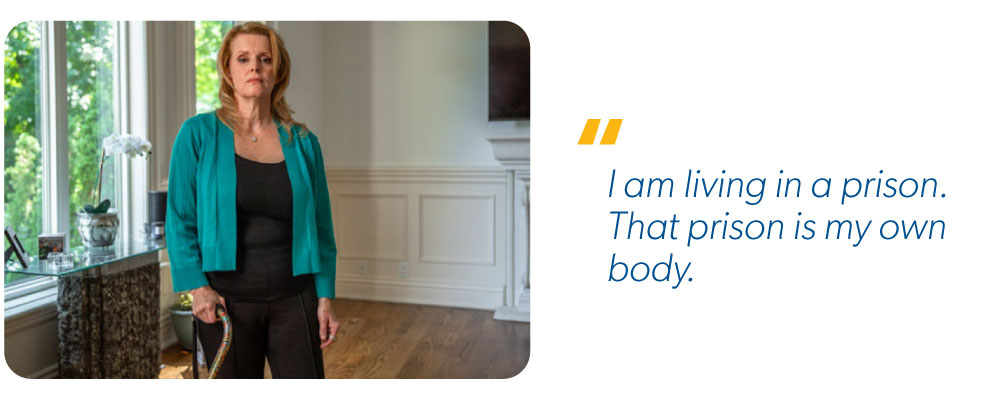What is Developmental Dysplasia of the Hip?
Characterized by hip sockets that don’t develop properly, hip dysplasia may not cause discomfort at first. But over time, deep pain in the groin and hip can become more common along with hip dislocation and cartilage tears. By the time these symptoms appear, it’s too late: treatment is more complex, and outcomes are not as likely to be successful.
If diagnosed early in infancy, hip dysplasia can be successfully treated within several weeks by wearing a soft brace – sparing a lifetime of pain and discomfort.
Emma’s story: How early detection could have changed her life
When Jasmin learned her daughter Emma’s hip dysplasia could have been detected at birth with a simple hand-held ultrasound scan, her heart sank.
Emma was diagnosed with severe hip dysplasia just before her second birthday, beginning a difficult journey for her parents and her — challenging decisions, anxious thoughts, a serious surgery with a long recovery, and countless appointments. Like every newborn in Canada, Emma’s hips were checked at birth by physically maneuvering them. No signs of concern were found, and she was given a clean bill of health. For months, everything seemed fine — until one day during a diaper change, Emma’s parents noticed that one of her legs appeared longer than the other. Jasmin immediately took her daughter to the doctor, and after another physical screening, they were told not to worry.
At 21 months, Emma started walking, but with a limp. “She didn’t have any pain, but all my concerns came rushing back,” says Jasmin. She sought help from a chiropractor who immediately recognized signs of possible hip dysplasia and urged her to get Emma X-rayed. The results were devastating — Emma’s femur was completely detached from her hip; she needed surgery urgently.

Jasmin was overwhelmed. “The surgery sounded so extreme and very invasive. How do you explain this to a two-year-old who just learned to walk, that she’s going to wake up and not be able to move?” she recalls.
And was surgery necessary when Emma wasn’t showing any signs of pain? Jasmin wondered.
The surgeon explained that if left untreated, hip dysplasia would lead to osteoarthritis and likely a hip replacement in early adulthood.
Jasmin and her husband decided to go forward with the surgery. “I had to think of future Emma,” says Jasmin. “If we didn’t deal with her hip dysplasia now, it would catch up with her. It would be much more disruptive and a much harder recovery because she’d be older.”

After surgery and six days in the hospital, Emma and Jasmin faced a long, uncomfortable nine weeks. “We had to learn how to maneuver around the big bulky body cast, change diapers, bathe her and keep her comfortable. While carefully navigating Emma’s healing, I just wanted to be able to cuddle her close, but the cast was a strange barrier.”
Though the cast came off, recovery hasn’t been easy. Emma is now in preschool and continues with physiotherapy and follow-up appointments. A year after surgery, signs suggest that a gap may be re-emerging in her hip, raising the possibility of another surgery. For now, Jasmin is focusing on helping Emma grow stronger, but the worry lingers.
“If Emma had been offered an ultrasound at birth, it’s possible we could have avoided so much pain, and spared the healthcare system so much expense,” Jasmin reflects.
Tina’s story: The high price of delayed treatment
What began as a treatable condition in infancy has spiralled into a lifetime of surgeries, debilitating chronic pain and lost opportunities.
Tina is no stranger to pain. Born with Developmental Dysplasia of the Hip that went untreated, she required several surgeries and hospital stays as a child.

With hip dysplasia being the leading cause for hip arthritis in women under 50* , this was a harbinger of what was to come — a future Tina would have given anything to avoid, had she known.
For about eight years between her late teens and early twenties, after recovering from many surgeries, she thrived.
And then that life crumbled with signs of arthritis. Sleep eluded her; walking got harder; and by the time she was 38, she had her first hip replaced.
Now 55 years old, Tina has severe osteoarthritis, which “presents like that of an 80-year-old,” according to her physician. “I am living in a prison,” she says. “That prison is my own body.”

There’s nothing that Tina can think of that arthritis hasn’t touched in her life. She feels like she exists looking out a window, watching her family and friends live their lives as she sits in a dark veil of pain that she tries to mask. “How do you explain in a conversation that there is an invisible attacker in the room, constantly stabbing you?” she says through tears. “That is my reality. Always under attack.”
Exhaustion plagues her, and the pain leaves her feeling emotionally drained – impacting her mental health, social life and relationships. “I often wake up in the middle of the night to find my pillow wet from crying in my sleep.”
Tina is sharing her story to inspire action for equitable and timely access to care. Tina’s difficult journey is a stark reminder of the profound consequences of what can happen when hip dysplasia in infants goes untreated. An early diagnosis and simple effective treatment could have spared her from the devastating impact of osteoarthritis.

